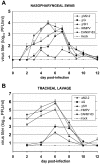Infection of nonhuman primates with recombinant human metapneumovirus lacking the SH, G, or M2-2 protein categorizes each as a nonessential accessory protein and identifies vaccine candidates
- PMID: 16160190
- PMCID: PMC1211552
- DOI: 10.1128/JVI.79.19.12608-12613.2005
Infection of nonhuman primates with recombinant human metapneumovirus lacking the SH, G, or M2-2 protein categorizes each as a nonessential accessory protein and identifies vaccine candidates
Abstract
Recombinant human metapneumovirus (HMPV) in which the SH, G, or M2 gene or open reading frame was deleted by reverse genetics was evaluated for replication and vaccine efficacy following topical administration to the respiratory tract of African green monkeys, a permissive primate host. Replication of the deltaSH virus was only marginally less efficient than that of wild-type HMPV, whereas the deltaG and deltaM2-2 viruses were reduced sixfold and 160-fold in the upper respiratory tract and 3,200-fold and 4,000-fold in the lower respiratory tract, respectively. Even with the highly attenuated mutants, there was unequivocal HMPV replication at each anatomical site in each animal. Thus, none of these three proteins is essential for HMPV replication in a primate host, although G and M2-2 increased the efficiency of replication. Each gene-deletion virus was highly immunogenic and protective against wild-type HMPV challenge. The deltaG and deltaM2-2 viruses are promising vaccine candidates that are based on independent mechanisms of attenuation and are appropriate for clinical evaluation.
Figures


Similar articles
-
Recombinant human Metapneumovirus lacking the small hydrophobic SH and/or attachment G glycoprotein: deletion of G yields a promising vaccine candidate.J Virol. 2004 Dec;78(23):12877-87. doi: 10.1128/JVI.78.23.12877-12887.2004. J Virol. 2004. PMID: 15542640 Free PMC article.
-
Deletion of M2 gene open reading frames 1 and 2 of human metapneumovirus: effects on RNA synthesis, attenuation, and immunogenicity.J Virol. 2005 Jun;79(11):6588-97. doi: 10.1128/JVI.79.11.6588-6597.2005. J Virol. 2005. PMID: 15890897 Free PMC article.
-
Deletion of human metapneumovirus M2-2 increases mutation frequency and attenuates growth in hamsters.Virol J. 2008 Jun 3;5:69. doi: 10.1186/1743-422X-5-69. Virol J. 2008. PMID: 18519001 Free PMC article.
-
Live vaccines for human metapneumovirus designed by reverse genetics.Expert Rev Vaccines. 2006 Oct;5(5):695-706. doi: 10.1586/14760584.5.5.695. Expert Rev Vaccines. 2006. PMID: 17181442 Review.
-
Cell-Mediated Responses to Human Metapneumovirus Infection.Viruses. 2020 May 14;12(5):542. doi: 10.3390/v12050542. Viruses. 2020. PMID: 32423043 Free PMC article. Review.
Cited by
-
Human metapneumovirus M2-2 protein inhibits RIG-I signaling by preventing TRIM25-mediated RIG-I ubiquitination.Front Immunol. 2022 Aug 15;13:970750. doi: 10.3389/fimmu.2022.970750. eCollection 2022. Front Immunol. 2022. PMID: 36045682 Free PMC article.
-
The cell biology of acute childhood respiratory disease: therapeutic implications.Pediatr Clin North Am. 2006 Oct;53(5):929-59, ix-x. doi: 10.1016/j.pcl.2006.08.004. Pediatr Clin North Am. 2006. PMID: 17027618 Free PMC article. Review.
-
Prophylactic and therapeutic approaches for human metapneumovirus.Virusdisease. 2018 Dec;29(4):434-444. doi: 10.1007/s13337-018-0498-5. Epub 2018 Oct 20. Virusdisease. 2018. PMID: 30539045 Free PMC article. Review.
-
Structure and immunogenicity of pre-fusion-stabilized human metapneumovirus F glycoprotein.Nat Commun. 2017 Nov 16;8(1):1528. doi: 10.1038/s41467-017-01708-9. Nat Commun. 2017. PMID: 29142300 Free PMC article.
-
Human metapneumovirus small hydrophobic (SH) protein downregulates type I IFN pathway signaling by affecting STAT1 expression and phosphorylation.Virology. 2016 Jul;494:248-56. doi: 10.1016/j.virol.2016.04.022. Epub 2016 Apr 27. Virology. 2016. PMID: 27131212 Free PMC article.
References
-
- Biacchesi, S., M. H. Skiadopoulos, G. Boivin, C. T. Hanson, B. R. Murphy, P. L. Collins, and U. J. Buchholz. 2003. Genetic diversity between human metapneumovirus subgroups. Virology 315:1-9. - PubMed
-
- Biacchesi, S., M. H. Skiadopoulos, K. C. Tran, B. R. Murphy, P. L. Collins, and U. J. Buchholz. 2004. Recovery of human metapneumovirus from cDNA: optimization of growth in vitro and expression of additional genes. Virology 321:247-259. - PubMed
-
- Biacchesi, S., M. H. Skiadopoulos, L. Yang, E. W. Lamirande, K. C. Tran, B. R. Murphy, P. L. Collins, and U. J. Buchholz. 2004. Recombinant human Metapneumovirus lacking the small hydrophobic SH and/or attachment G glycoprotein: deletion of G yields a promising vaccine candidate. J. Virol. 78:12877-12887. - PMC - PubMed
MeSH terms
Substances
LinkOut - more resources
Full Text Sources
Other Literature Sources

